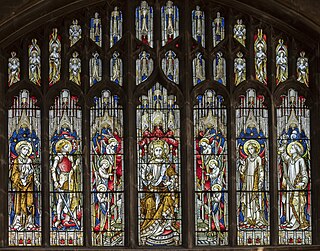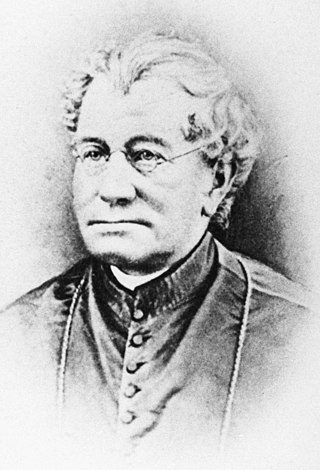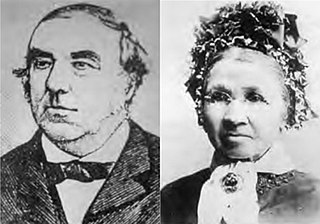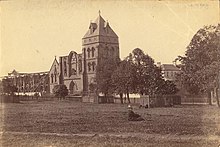
Augustus Welby Northmore Pugin was an English architect, designer, artist and critic with French and Swiss origins. He is principally remembered for his pioneering role in the Gothic Revival style of architecture. His work culminated in designing the interior of the Palace of Westminster in Westminster, London, and its renowned clock tower, the Elizabeth Tower, which houses the bell known as Big Ben. Pugin designed many churches in England, and some in Ireland and Australia. He was the son of Auguste Pugin, and the father of Edward Welby Pugin, Cuthbert Welby Pugin, and Peter Paul Pugin, who continued his architectural and interior design firm as Pugin & Pugin.

The Australian Catholic Church or Catholic Church in Australia is part of the worldwide Catholic Church under the spiritual and administrative leadership of the Holy See. From origins as a suppressed, mainly Irish minority in early colonial times, the church has grown to be the largest Christian denomination in Australia, with a culturally diverse membership of around 5,075,907 people, representing about 20% of the overall population of Australia according to the 2021 ABS Census data.

The Cathedral Church and Minor Basilica of the Immaculate Mother of God, Help of Christians, Patroness of Australia is the cathedral church of the Roman Catholic Archdiocese of Sydney and the seat of the Archbishop of Sydney, currently Anthony Fisher OP. It is dedicated to the "Immaculate Mother of God, Help of Christians", Patroness of Australia and holds the title and dignity of a minor basilica, bestowed upon it by Pope Pius XI on 4 August 1932.

Hardman & Co., otherwise John Hardman Trading Co., Ltd., founded 1838, began manufacturing stained glass in 1844 and became one of the world's leading manufacturers of stained glass and ecclesiastical fittings. The business closed in 2008.

John Hubert Plunkett was Attorney-General of New South Wales, an appointed member of the Legislative Council 1836–41, 1843–56, 1857–58 and 1861–69. He was also elected as a member of the Legislative Assembly 1856–60. He is best known for the prosecution of the colonists who brutally murdered 28 Aboriginals in the Myall Creek Massacre of 1838, seven of whom were convicted and hanged.

James Alipius Goold was an Australian Augustinian friar and the founding Catholic Archbishop of Melbourne in Australia.

John Therry was an Irish Roman Catholic priest in Sydney, Australia.

Sir Roger Therry was an Irish-Australian jurist and member of the New South Wales Legislative Council.

Bishop Francis Murphy was an Irish-born Roman Catholic priest and first Catholic Bishop of Adelaide, South Australia.
Henry Fulton was a Church of Ireland curate who, as a United Irishman in 1798, was transported to New South Wales where in the Rum Rebellion, and the subsequent inquiries, he took the part of Governor William Bligh.

Arthur Wolfe, 1st Viscount Kilwarden was an Anglo-Irish peer, politician and judge, who held office as Lord Chief Justice of Ireland. He was killed during the Irish rebellion of 1803.
Atlas was a sailing ship built in Quebec by William Baldwin and launched in 1801 for W. Beateson & Company, London.

Thomas Poynton and Mary Poynton and their children were among the first Catholic families to settle in New Zealand. They were instrumental in bringing Bishop Jean Baptiste Pompallier to New Zealand and were involved in the growth of Catholicism and Catholic missions in the Hokianga and later on in the North Shore of Auckland.
Peter Ivers was a recruiter and strategist for the United Irishmen, a mass-membership organisation committed to, an ultimately insurrectionary, struggle against the British Crown and Protestant Ascendancy in Ireland for a representative national government. He was arrested on the eve of the Rebellion of 1798 and transported to Australia.
Eris O'Brien was an Australian prelate of the Catholic Church and historian. He was Auxiliary Bishop of Sydney, New South Wales, Australia (1948–1951) and the second archbishop of the Canberra-Goulburn (1953–1966).

St Anne's Roman Catholic Church is a heritage-listed Roman Catholic school and church building located at St Annes Square, Strathfield South in the Municipality of Strathfield local government area in Sydney, Australia. It was built from 1859 to 1864. It is also known as St. Anne's Roman Catholic Church (former) and St Anne's Catholic Church. It was added to the New South Wales State Heritage Register on 2 April 1999.

St John's Roman Catholic Church and Cemetery is a heritage-listed former school and now Roman Catholic church building located in George Street in Campbelltown. It was designed by John Joseph Therry and built from 1824 to 1841. It is also known as St Johns Roman Catholic Church and Cemetery (former), Saint Johns Roman Catholic Church and Old St John's Church. It was added to the New South Wales State Heritage Register on 2 April 1999. The current church, called St John the Evangelist Catholic Church was built in 1886 and is located at Cordeaux Street, Campbelltown in the City of Campbelltown local government area of New South Wales, Australia. The property is owned by Trustees of the Roman Catholic Church for the Diocese of Wollongong.

John Leamy was an Irish-born American merchant who pioneered Philadelphia's trade with the Spanish colonies in the Americas. He was a founder of the Insurance Company of North America and the Hibernian Society. As an active Roman Catholic, he helped fund the construction of St. Augustine Church, was a trustee at St. Mary's and there participated in the Hogan schism.
Catherine Fitzpatrick (1785–1861), née Milling, was the founder and first conductor of St. Mary's Cathedral Choir, in Sydney, Australia.
James Dixon (1758-1840) was an Irish Catholic priest who was transported to Australia and in 1803 became the first Catholic priest permitted to minister there.
















